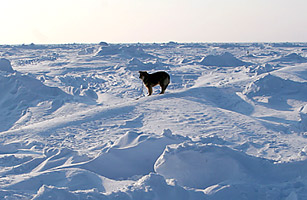
Ninety-one years after two Americans, Robert Edwin Peary and Frederick Albert Cook, both claimed to have been the first to reach the North Pole, experts are still arguing over which of them — if either — turned the trick. Certainty remains elusive.
Cook's case is weaker, not least because Cook is such a lousy character witness for himself. A physician, he was, to be sure, also an accomplished outdoorsman. He had served as surgeon on Peary's first Arctic expedition in 1891 and had done some serious mountaineering in the years prior to his North Pole assault. But consider the mountaineering as Exhibit A against the man: In 1906, Cook stated that he had made the first successful ascent of Alaska's Mount McKinley. Later, his summit photographs were revealed as fakes, and Cook's climbing partner recanted his corroboration. Exhibit B could be Cook's conviction for mail fraud, a smear erased — sort of — by a presidential pardon in 1940, the year of Cook's death. So that's Frederick A. Cook.
Peary was no sweetheart either. The U.S. Navy commander was unlikable, arrogant and extraordinarily self-involved. A married man with a son and a daughter, he fathered two Eskimo children during his Arctic adventures. (Though he associated with Eskimos during his entire career, Peary proved to be no friend to the northern people: As detailed in Kenn Harper's Give Me My Father's Body: The Life of Minik, The New York Eskimo, in 1897 Peary presented six Eskimos as "specimens" to the American Museum of Natural History in New York City. Four of the group died almost immediately of influenza.) Peary once said of Matthew Henson, his African American assistant of 22 years, "Henson must go all the way. I can't make it without him." Throughout the Arctic, Henson cooked, built igloos, tended the dogs and walked every cold and painful step, while his boss was hauled on a sledge by Eskimos. But when evidence indicated that Henson had quite possibly reached the Pole before him, Peary never spoke to the man again. So that's Robert E. Peary.
Cook and Peary were right for the task, as the goal they had in sight could be reached only by a driven man of considerable ego. The North Pole was the single greatest target for adventurers at the turn of the century. In the 1890s the Norwegian Fridtjof Nansen sailed his ship to Spitsbergen but ultimately failed to reach the Pole; the Swede Salomon Andrée tried to reach the Pole by balloon but failed; Peary tried for the Pole on dogsled but failed. The North Pole, floating on a sea 13,410 feet deep, its surface ice perpetually shifting and drifting, cracking and freezing again, was a cruel siren: By the early 20th century it had already claimed the lives of hundreds of adventurers.
Peary, 52, felt certain that his 1908 expedition would be his last. His six previous trips to the Arctic had earned him considerable renown — in 1891-92 he had proved Greenland to be an island by exploring its northern coast, and his 1905 polar trek had established a farthest-north record — but he would remain unfulfilled if he did not reach 90 degrees north.
He either did or did not do so on April 6, 1909, after an over-the-ice journey of 37 days, accompanied on the last stretch by Henson and four Eskimos. Before Peary could even cable the news, his old colleague Cook blindsided him by announcing from the Shetland Islands that he had stood atop the world a full year earlier. It seemed, initially, that he might have, but the journals he presented as proof were said by experts to have been doctored, and the Eskimo guides that Cook trotted out as witnesses proved as worthy as his McKinley corroborator. The Eskimos finally admitted that Cook had, in fact, never left sight of land — land that ends hundreds of miles south of the Pole.
In recent years, Peary's claim has also come under a cloud: Did he get there? Were his measurements accurate? The truth may never be known. In 1989 the National Geographic Society, after commissioning the Navigation Foundation to spend more than a year investigating 225 cubic feet of documents, announced that Peary, who had been made a rear admiral before his death in 1920, had very likely come within five miles of the North Pole — and perhaps had stood upon the spot itself. Whatever the truth is, favor does seem to rest much more comfortably with Peary than with Cook. As Peter Freuchen, the noted Danish explorer and writer who knew both men, once put it: "Cook was a liar and a gentleman; Peary was neither."